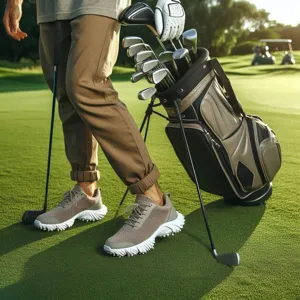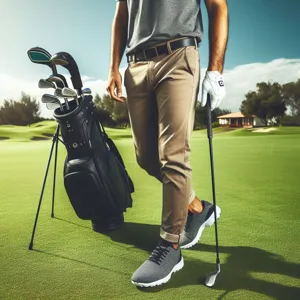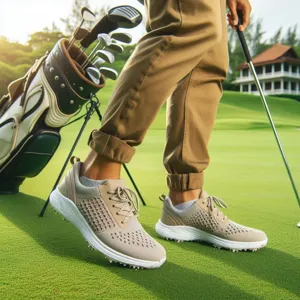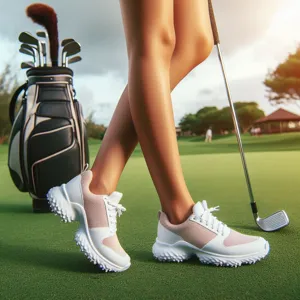When it comes to basketball, the right pair of shoes can make all the difference between a game-winning performance and a frustrating day on the court.
With a plethora of options available, finding the perfect fit can feel overwhelming, especially with the diverse styles, technologies, and designs that cater to various playing styles and player preferences. Whether you’re a quick guard looking for lightweight agility, a powerful forward in need of superior ankle support, or a versatile player seeking all-around comfort, understanding the different types of basketball shoes is essential to elevate your game. In this comprehensive guide, we’ll break down the various categories of basketball footwear, explore the latest innovations in shoe technology, and help you discover the ideal pair that meets your unique needs and enhances your performance, allowing you to hit the court with confidence and style.
1. Introduction to Basketball Shoes: Why the Right Fit Matters
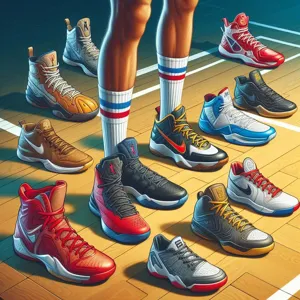
When it comes to basketball, the right pair of shoes can make all the difference. Not only do basketball shoes provide the critical support and cushioning needed to enhance performance on the court, but they also play a vital role in preventing injuries. A well-fitted shoe can enhance your agility, improve your jumping ability, and provide the necessary traction to pivot and sprint effectively.
Imagine this: you’re dribbling down the court, feeling the adrenaline rush as you prepare to take the shot. Suddenly, you feel a slip or discomfort in your shoes. This momentary lapse can disrupt your focus and even lead to injuries that sideline you for weeks. That’s why understanding the different types of basketball shoes available is essential. Whether you’re a point guard looking for lightweight speed, a center requiring maximum support, or a casual player hitting the court for fun, choosing the right fit can elevate your game and boost your confidence.
Moreover, with countless brands and styles to choose from, finding the perfect basketball shoe can feel overwhelming. Each type is designed with specific features tailored to different playing styles and court conditions. In this guide, we’ll delve into the various types of basketball shoes, helping you understand what to look for in terms of fit, support, and performance-enhancing technology. By the end of this journey, you’ll be well-equipped to make an informed decision and find the pair that feels like an extension of your own foot, allowing you to play your best game yet.
2. Understanding the Anatomy of Basketball Shoes
When diving into the world of basketball shoes, understanding their anatomy is key to finding the perfect fit for your gameplay. Each component of a basketball shoe is designed with a specific purpose, contributing to your overall performance on the court.
**1. Upper:** The upper is the shoe’s outer layer, typically made from a combination of materials like mesh, synthetic leather, or nubuck. This part provides the structure and support needed for your foot. Look for a lightweight upper that offers breathability without sacrificing durability. A snug fit around the midfoot can enhance stability, which is crucial for quick cuts and aggressive movements.
**2. Lacing System:** The lacing system is more than just aesthetics; it plays a vital role in securing your foot within the shoe. Whether it’s standard laces, a strap system, or a quick-lacing mechanism, the right lacing method can help prevent heel slippage and ensure a locked-in feel during gameplay. A well-fitted shoe will allow you to focus on your performance rather than adjusting your footwear mid-game.
**3. Midsole:** The midsole acts as the shoe’s cushioning system, absorbing impact and providing comfort. This layer is often made from foam or specialized materials like EVA or TPU, which can vary in density and responsiveness. A shoe with a well-cushioned midsole will help you feel more comfortable during those long hours on the court, while also providing the necessary bounce to enhance your vertical leap.
**4. Outsole:** The outsole is the part of the shoe that makes contact with the court. Typically crafted from rubber, it features different tread patterns that offer traction and grip. A herringbone pattern is common for its ability to provide multi-directional traction, which is crucial for quick stops and pivots. Pay attention to the outsole’s durability; a well-constructed outsole will withstand the wear and tear of various playing surfaces.
**5. Heel Counter:** This is the stiff material located at the back of the shoe that surrounds your heel. A proper heel counter helps maintain the shoe’s shape while providing support and stability. Ensuring that the heel counter fits snugly can prevent injuries and enhance your overall comfort as you maneuver on the court.
**6. Ankle Support:** Depending on your playing style and personal preference, you may opt for low, mid, or high-top basketball shoes. High-tops provide additional ankle support, which can be beneficial for players who are prone to ankle injuries or require extra stability during high-impact movements. Mid-tops offer a balance between support and agility, while low-tops allow for greater freedom of movement, catering to faster players.
By familiarizing yourself with these components, you can make informed decisions when selecting basketball shoes that not only fit well but also enhance your performance on the court. Remember, the right shoe can be a game-changer, helping you to elevate your skills and enjoy the game even more!
3. Types of Basketball Shoes: An Overview
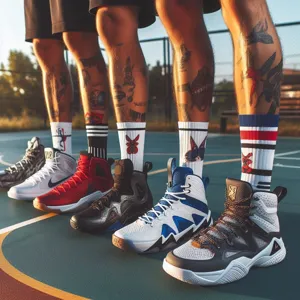
When it comes to choosing the right basketball shoes, understanding the various types available can make all the difference in your game. Basketball shoes are not just about style; they are designed to enhance performance, provide support, and offer the right grip on the court. Here’s an overview of the main types of basketball shoes and their distinct features:
1. **High-Top Shoes**: Known for their ankle support, high-top basketball shoes are a favorite among players who prioritize stability. The extended collar of these shoes wraps around the ankle, helping to prevent injuries during quick cuts and jumps. They are ideal for big men and anyone who plays a more physical game, providing the necessary support for those hard landings.
2. **Mid-Top Shoes**: Striking a balance between agility and support, mid-top shoes offer moderate ankle coverage. These shoes are a versatile option for players who like to move quickly while still needing some level of protection. They allow for better mobility compared to high-tops, making them a popular choice for guards and forward players who rely on speed and finesse.
3. **Low-Top Shoes**: For those who crave freedom of movement, low-top basketball shoes are the way to go. With a design that allows for the greatest range of motion, these shoes are lightweight and often favored by guards who thrive on speed and agility. However, they provide less ankle support, so players who choose this style should be cautious and ensure they have strong ankle stability.
4. **Performance Shoes**: Tailored specifically for on-court action, performance basketball shoes are packed with advanced technology that enhances gameplay. They often feature responsive cushioning, dynamic traction patterns, and lightweight materials. Brands like Nike, Adidas, and Under Armour invest in research and development to create shoes that cater to different playing styles and positions.
5. **Lifestyle Shoes**: While not strictly designed for playing basketball, lifestyle shoes are inspired by the game and often feature stylish aesthetics. These shoes can be worn off the court and are perfect for fans or casual wear. While they may not provide the best support or traction for serious play, they can certainly make a fashion statement.
As you explore your options, consider your playing style, position, and personal preferences. The right basketball shoe can enhance your performance, boost your confidence, and keep you comfortable throughout those intense games, making it essential to find the perfect fit for your unique needs. With this overview, you’re one step closer to discovering the ideal basketball shoe that will help elevate your game to new heights.
4. High-Top vs. Low-Top: Pros and Cons
When it comes to choosing the right basketball shoe, one of the most significant decisions you’ll face is whether to go with high-tops or low-tops. Each style comes with its own set of advantages and drawbacks, making it crucial to understand what suits your playing style and personal preferences best.
**High-Top Basketball Shoes: Pros and Cons**
High-top basketball shoes are designed to provide additional ankle support and stability, making them a popular choice among players who prioritize protection. The extended height of these shoes wraps around the ankle, which can help prevent injuries during aggressive movements on the court. This added security is especially beneficial for players who rely on quick cuts, jumps, and lateral movements, as it minimizes the risk of rolling an ankle or sustaining other injuries.
However, the trade-off for this support is often a heavier shoe that may restrict some freedom of movement. High-tops can feel bulky, and for players who thrive on speed and agility, the additional weight may hinder their performance. Additionally, they can take longer to break in, which can be a consideration if you’re looking to hit the court right away.
**Low-Top Basketball Shoes: Pros and Cons**
On the flip side, low-top basketball shoes are favored for their lightweight design and increased flexibility. These shoes allow for a greater range of motion around the ankle, making them ideal for guards and players who rely on speed, agility, and quick footwork. Low-tops promote a more natural feeling of movement, which can enhance your ability to make sharp turns and explosive sprints.
However, the lack of ankle support that comes with low-tops can be a drawback for some players. If you’re prone to ankle injuries or play in a more physical style, the reduced protection might leave you feeling vulnerable. It’s essential to weigh your playing style against the risks; while low-tops can enhance performance in terms of speed, they may not provide the security needed for more aggressive play.
Ultimately, the choice between high-tops and low-tops comes down to your personal preferences, playing style, and any specific needs you may have. Whether you prioritize support and stability or speed and agility, understanding the pros and cons of each type will help you find the perfect fit for your game.
5. Mid-Top Shoes: The Best of Both Worlds
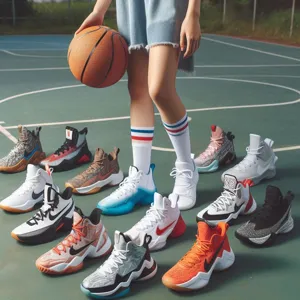
Mid-top basketball shoes strike a harmonious balance between the ankle support of high-tops and the lightweight agility of low-tops, making them a versatile choice for players of all styles. This hybrid design offers the best of both worlds, catering to those who require stability without sacrificing mobility on the court.
The mid-top construction typically features a collar that rises just above the ankle, providing enough support to help prevent injuries while still allowing for a full range of motion. This is particularly beneficial during quick lateral movements and explosive jumps, where a player’s ability to pivot and change direction is crucial.
Moreover, mid-top shoes are often designed with a blend of cushioning and responsiveness, allowing players to feel connected to the floor without feeling weighed down. The cushioning systems, such as EVA foam or proprietary technologies like Nike’s Air or Adidas’ Boost, absorb impact, making every landing softer and every push-off more explosive.
Style-wise, mid-tops also tend to be more versatile off the court, seamlessly transitioning into casual wear. With a plethora of colorways and designs available, players can express their individual style while ensuring comfort and performance in their footwear. Whether you’re a guard looking for speed or a forward needing that extra support, mid-top basketball shoes offer a reliable choice that can adapt to your game and lifestyle.
In summary, if you’re seeking a shoe that provides solid ankle support without compromising on agility, mid-tops may just be your perfect fit. As you explore options, keep in mind the specific features that cater to your playing style, and you’ll be well on your way to finding your ideal pair.
6. Cushioning Technologies: Impact on Performance and Comfort
Cushioning technologies play a pivotal role in enhancing both performance and comfort in basketball shoes, making them a crucial aspect to consider when selecting the ideal pair for your game. The right cushioning not only protects your feet and joints from the high-impact nature of basketball but also contributes to your overall agility, stability, and energy return on the court.
Modern basketball shoes utilize a variety of innovative cushioning systems, each designed to address specific needs and preferences. For example, Nike’s Air technology incorporates pressurized air units that compress and expand with each step, providing lightweight cushioning that enhances responsiveness without compromising ground feel. This can be particularly beneficial for players who thrive on quick movements and need an extra spring in their step when leaping for rebounds or making explosive cuts.
Adidas, on the other hand, has revolutionized the cushioning game with its Boost technology, which features energy-returning foam that offers exceptional comfort and support. This cushioning absorbs the shock of impact while providing a soft, plush feel underfoot, making it ideal for players who prioritize comfort during long hours of play. The unique blend of responsiveness and plushness can help reduce fatigue, allowing players to maintain their performance levels throughout an intense game.
Another popular option is the EVA (Ethylene Vinyl Acetate) foam, commonly used in many basketball shoes for its lightweight nature and ability to provide decent cushioning. While EVA is a more traditional choice, advancements in manufacturing processes have led to variations that enhance durability and comfort. Some brands are even experimenting with different densities of EVA to cater to various playing styles—offering softer options for guards who require agility and firmer variations for forwards who need stability.
Ultimately, the choice of cushioning technology comes down to personal preference and playing style. Whether you seek the responsiveness of air units, the plush comfort of Boost, or the balance offered by EVA, understanding how each technology impacts your performance can lead to a more informed decision. When trying on basketball shoes, pay attention to how the cushioning feels during movement; a shoe that provides both comfort and adequate support can significantly enhance your on-court experience and help you play at your best.
7. Traction Patterns: Choosing the Right Sole for Your Playing Style
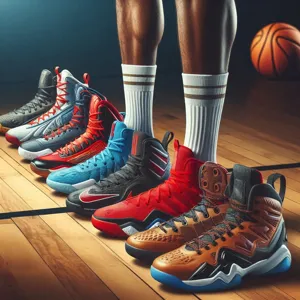
When it comes to basketball shoes, the sole’s traction pattern can significantly impact your performance on the court. Choosing the right sole is essential for providing the grip you need to make those explosive movements, sharp cuts, and quick stops. The right traction will not only enhance your agility but also boost your confidence as you navigate the game.
Traction patterns are often categorized into two main types: herringbone and circular. Herringbone patterns, characterized by their zigzag design, offer superior grip on both indoor and outdoor courts. This pattern excels in multi-directional movements, making it ideal for players who rely on agility and quick lateral movements. If you frequently play in competitive settings where rapid changes of direction are essential, a shoe with a deep herringbone pattern will help you stay grounded.
On the other hand, circular traction patterns, often resembling concentric circles, provide excellent pivoting capabilities. This design is particularly beneficial for post players or those who spend a lot of time in the paint, as it allows for smooth rotations while maintaining grip. If your playing style involves a lot of post-up moves or spins, shoes with this type of traction will enhance your stability and control.
Moreover, consider the type of court you’ll be playing on. Indoor courts generally provide more grip than outdoor surfaces, which can be rougher and wear down shoe soles faster. If you play outdoors frequently, look for shoes with durable rubber and a more aggressive traction pattern to withstand the wear and tear of asphalt or concrete.
Ultimately, choosing the right traction pattern is about recognizing your playing style and the environments you frequent. Whether you need the sharp responsiveness of herringbone or the pivot-friendly design of circular patterns, understanding these nuances can enhance your game and keep you performing at your best.
8. Evaluating Fit: How to Choose the Right Size
When it comes to basketball shoes, the right fit can make all the difference between a stellar performance on the court and a frustrating game marred by discomfort. Evaluating fit is not just about finding the right size; it’s about understanding how the shoe interacts with your foot during movement, providing both support and flexibility. Here are some key factors to consider when choosing the right size for your basketball shoes.
**1. Measure Your Feet:** Always start by measuring your feet; foot size can change over time, and different brands may have different sizing charts. Stand on a piece of paper and trace the outline of your foot. Measure the distance from the heel to the longest toe and do this for both feet, as many people have one foot slightly larger than the other.
**2. Consider Width and Arch Type:** Width is just as crucial as length. Many brands offer shoes in various widths, including narrow, standard, and wide options. If you have a wider foot, look for brands that cater to this need. Additionally, understanding your arch type (high, medium, or flat) can help you select a shoe that offers the right level of support.
**3. Try Before You Buy:** Whenever possible, try on shoes in-store. It’s ideal to do this later in the day when your feet are slightly swollen, mimicking how they will feel during a game. Wear the same type of socks you intend to use when playing, and make sure to walk, jump, and even run in the shoes to assess comfort and fit.
**4. Allow for a Little Room:** A good rule of thumb is to leave about a thumb’s width of space between your longest toe and the front of the shoe. This extra space allows for movement as you pivot and sprint on the court, preventing painful toe jams while ensuring your foot is snugly held in place.
**5. Pay Attention to the Heel:** Your heel should feel secure without slipping. A well-fitting shoe should hold your heel firmly, reducing the risk of blisters and providing stability during lateral movements. If the shoe feels loose around the heel, it may not be the right fit for you.
**6. Break Them In:** Finally, remember that most basketball shoes require a break-in period. While they should feel comfortable from the start, give them a few sessions to mold to your feet. However, if they consistently cause discomfort, don’t hesitate to explore other options.
Finding the perfect fit in basketball shoes is essential for elevating your game. With the right size and shape, you can enhance your performance and enjoy every moment on the court, helping you focus on what truly matters: the game itself.
9. Materials Matter: Breathability, Durability, and Support
When it comes to selecting the right basketball shoes, understanding the materials used in their construction is crucial for enhancing performance on the court. Breathability, durability, and support are key factors that can significantly impact your overall playing experience.
**Breathability** is essential for keeping your feet cool and comfortable during intense games. Look for shoes that feature mesh panels or ventilated uppers, as these materials allow for better airflow, helping to wick away sweat and prevent overheating. A well-ventilated shoe can make all the difference, especially in high-stakes situations when every second counts.
**Durability** is another important aspect to consider. Basketball shoes endure a lot of wear and tear, particularly if you play frequently or on outdoor courts. Materials like rubber outsoles and synthetic overlays can enhance a shoe’s lifespan, providing the resilience needed to withstand the rigors of the game. Shoes crafted with reinforced stitching and high-quality materials will not only last longer but also maintain their shape and performance over time.
Finally, **support** is paramount for preventing injuries and ensuring optimal performance. Look for shoes that offer ample cushioning and arch support, as well as a secure fit around the ankle. High-top designs often provide additional ankle support, reducing the risk of sprains during quick lateral movements. However, mid and low-top options can also offer great support if they incorporate the right materials and technology.
In short, when choosing basketball shoes, pay close attention to the materials used in their construction. Prioritizing breathability, durability, and support will help you find a pair that not only feels great but also enhances your game, allowing you to play at your best.
10. Position-Specific Recommendations: Guards, Forwards, and Centers
When it comes to basketball, the type of shoe you choose can significantly impact your performance on the court. Different positions have unique demands, and understanding these can help you select the perfect pair tailored to your playing style. Here’s a closer look at position-specific recommendations for guards, forwards, and centers.
**Guards**: Speed and agility are the names of the game for guards. These players need shoes that promote quick movements, sharp cuts, and explosive speed. Look for lightweight options with a low profile, as they allow for greater freedom of movement. Shoes with responsive cushioning systems, like Nike’s Zoom Air or Adidas’ Boost technology, can provide the necessary support during those fast breaks. Consider models with a herringbone outsole for optimal traction on the court, ensuring you can pivot and change directions without slipping.
**Forwards**: Forwards, who often balance speed and strength, require a shoe that offers both stability and support. Look for mid-top or high-top designs that provide adequate ankle support, especially as forwards frequently drive to the basket and engage in physical play. Shoes with a balanced cushioning system will absorb impact while still allowing for mobility. Models with reinforced overlays can add durability, which is essential for forwards who often battle for rebounds or take on aggressive defenders.
**Centers**: Dominating the paint requires a shoe that can handle the demands of power and impact. Centers should opt for shoes that are built with solid support and cushioning to protect against the stress of jumping and landing. High-top designs are particularly beneficial, as they provide extra ankle protection during intense plays. Look for shoes with a robust traction pattern to navigate the court effectively while maintaining a solid grip during rebounds. The cushioning should be plush yet responsive, allowing for comfort without sacrificing performance.
By considering the specific needs of your position, you can find basketball shoes that enhance your game and help you perform at your best. Whether you’re weaving through defenders as a guard, making powerful drives as a forward, or asserting your dominance in the paint as a center, the right footwear will elevate your performance and keep you one step ahead of the competition.
11. Budget vs. Performance: Finding Your Ideal Price Point
When it comes to selecting basketball shoes, the delicate balance between budget and performance is a critical consideration for every player, whether you’re a seasoned athlete or just starting out. The market is flooded with options that span a wide range of prices, and while it may be tempting to snag the most affordable pair on the shelf, understanding the implications of your choice can significantly impact your game.
Performance-driven basketball shoes often come with advanced features designed to enhance your playing experience. These high-end models may include cutting-edge cushioning technology, superior traction patterns, and lightweight materials that promote agility on the court. Brands like Nike, Adidas, and Under Armour frequently release performance shoes that are favored by professionals and can greatly enhance your speed, comfort, and overall effectiveness in the game. However, these benefits come at a cost, often ranging anywhere from $100 to upwards of $200 or more.
On the other hand, budget-friendly options can still offer decent support and traction, especially for recreational players who may not be hitting the court every day. Shoes in the lower price range, typically between $50 and $100, can provide adequate performance without breaking the bank. While they may lack some of the latest technologies found in high-end models, many brands have worked to create shoes that balance affordability with functionality, making them a suitable choice for casual players or those just beginning to hone their skills.
Ultimately, finding your ideal price point involves assessing your playing style, frequency of play, and personal budget. If basketball is your passion and you play regularly, investing in a higher-end pair may be worth the splurge to ensure optimal performance and durability. Conversely, if you’re looking for an introductory shoe or play sporadically, a budget option may serve you just fine. Remember, the perfect fit isn’t solely about the price tag—it’s about what feels right for your feet and your game.
12. Popular Brands and Their Unique Offerings
When it comes to basketball shoes, the brand you choose can significantly influence both your performance on the court and your personal style off of it. Each brand brings its own unique touch, catering to different player preferences, playing styles, and even aesthetic tastes. Here, we’ll delve into some of the most popular basketball shoe brands and highlight what sets them apart.
**Nike**: A titan in the basketball shoe market, Nike is synonymous with innovation and performance. Their Air Jordan line, launched in collaboration with basketball legend Michael Jordan, has become a cultural icon. Nike incorporates cutting-edge technology, such as Flyknit and Zoom Air, to provide superior comfort and responsiveness. If you’re looking for a shoe that balances style with high-performance features, Nike is often the go-to choice.
**Adidas**: Known for its sleek designs and comfortable fits, Adidas brings its own flair to the basketball court. The Boost technology, featured in many of their models, offers exceptional cushioning, making them ideal for players who prioritize comfort during play. The Adidas Harden line, inspired by superstar James Harden, is particularly popular for its unique aesthetics and ability to adapt to various playing styles.
**Under Armour**: While relatively newer to the basketball scene, Under Armour has quickly made a name for itself with its performance-driven designs. The Curry line, endorsed by NBA superstar Stephen Curry, offers lightweight construction and excellent grip, catering to players who rely on speed and agility. Under Armour’s focus on moisture-wicking technology also helps keep your feet cool and dry during intense games.
**Puma**: After making a comeback in the basketball shoe market, Puma has introduced some eye-catching designs that appeal to younger players. Their Clyde Court line combines retro aesthetics with modern technology, offering a comfortable fit and responsive cushioning. Puma’s collaboration with artists and athletes ensures that their shoes not only perform well but also make a bold statement on and off the court.
**New Balance**: Known for their commitment to comfort and quality, New Balance has carved out a niche in the basketball footwear realm. Their Kawhi Leonard signature shoe emphasizes stability and support, making it an excellent option for players who need that extra bit of protection during aggressive play. With their signature style and focus on fit, New Balance shoes are a great choice for both performance and casual wear.
By understanding what each brand offers, you can better navigate the vast landscape of basketball shoes and find a pair that meets your specific needs—whether you’re an explosive guard, a dominant post player, or someone who simply loves to shoot hoops for fun. With the right shoes, you’ll not only enhance your game but also leave your mark on the court in style.
13. How to Test Basketball Shoes: In-Store vs. Online
When it comes to finding the perfect pair of basketball shoes, the way you test them can significantly impact your purchasing decision. The two primary avenues for trying out shoes—shopping in-store versus online—each come with their own set of advantages and challenges. Understanding these can help you make a more informed choice.
### In-Store Testing
Shopping for basketball shoes in-store allows you to experience the shoes firsthand. As you step into the store, the smell of fresh rubber and the sight of vibrant soles await you. This tactile experience is invaluable. You can physically try on several pairs, assessing their fit, comfort, and style.
As you lace them up, walk around, and even simulate basketball movements—like dribbling or jumping—you can gauge how well the shoe supports your foot and holds up during play. Pay attention to the cushioning, arch support, and grip on the sole; these elements are crucial for your performance on the court. Additionally, in-store staff can often provide expert guidance, helping you find models that best suit your playing style and foot shape.
### Online Testing
On the other hand, shopping online offers a different kind of convenience. With just a few clicks, you can access a vast array of brands, styles, and prices that may not be available in your local stores. However, this convenience comes with the challenge of not being able to physically try on the shoes before purchasing.
To effectively test basketball shoes online, look for retailers that offer detailed size guides and customer reviews. Many brands also provide comprehensive product descriptions that include information about materials, cushioning technologies, and performance features. If possible, choose retailers with a good return policy, allowing you to try on the shoes at home and return them if they don’t meet your expectations.
When testing online, consider using a measuring tape to check your foot size and width at home, ensuring you select the right size for your needs. Additionally, some companies offer virtual fitting tools or augmented reality features that help visualize how the shoes may fit on your feet.
### Conclusion
Whether you opt for the in-store experience or the convenience of online shopping, testing basketball shoes effectively is key to finding your perfect fit. Take your time, weigh the pros and cons of each method, and remember that the right shoes can make a significant difference in your performance and enjoyment of the game. Ultimately, whether you’re sinking threes or driving to the hoop, the right fit is essential for maximizing your potential on the court.
14. Care and Maintenance for Longevity
When it comes to basketball shoes, proper care and maintenance can significantly extend their lifespan, ensuring you get the most out of your investment. First and foremost, always keep your shoes clean. After every game or practice, take a moment to wipe off dirt and grime with a damp cloth. This not only helps maintain their appearance but also prevents debris from wearing down the material over time.
Next, consider rotating your basketball shoes. Just like any other athletic gear, giving your shoes a break allows the materials to recover and reduces wear, especially if you play frequently. If possible, invest in a second pair so you can alternate between them. This practice keeps your shoes in top condition while providing you with a backup when one pair needs cleaning.
Storage is also crucial. Avoid leaving your shoes in hot, humid environments, such as a closed car or the gym locker. Excessive heat can warp the shoe’s structure and degrade the materials. Instead, store them in a cool, dry place, ideally in a breathable shoe bag or box that allows air circulation.
Lastly, pay attention to the soles. If you notice the traction wearing down, consider using a rubber sole cleaner or a specialized shoe care product to maintain grip. For those investing in high-end models, look into protective sprays that can shield against scuffs and stains.
By incorporating these simple maintenance habits into your routine, you can ensure that your basketball shoes remain in peak condition, allowing you to perform at your best while enjoying the game you love.
15. Conclusion: Making the Final Decision on Your Perfect Fit
In conclusion, choosing the right basketball shoes is a crucial step towards enhancing your game on the court. With a myriad of options available, it can be overwhelming to navigate through the various styles, technologies, and brand offerings. However, by understanding your playing style, foot shape, and the specific features that different shoes provide, you can make an informed decision that aligns with your needs.
As you weigh your options, consider factors such as cushioning for comfort, traction for grip, and support for stability. Whether you’re a fast-paced guard who thrives on agility or a powerful center who relies on strength, there’s a shoe designed specifically for your gameplay. Don’t forget the importance of fit; a snug yet comfortable fit can significantly impact your performance and reduce the risk of injuries.
Take the time to try on multiple pairs, paying attention to how they feel during movement. Remember that the perfect basketball shoe is not just about aesthetics—it’s about how well it complements your style of play and supports your body. Once you’ve found the pair that feels right, trust your instincts and make that investment. After all, the right shoes can elevate your game and boost your confidence on the court.
Now that you’re equipped with the knowledge to find your perfect fit, lace up and get ready to take your game to the next level!
In conclusion, finding the perfect pair of basketball shoes is essential for both performance and comfort on the court. With a myriad of options available, each designed to cater to different playing styles, foot shapes, and preferences, our guide has illuminated the key features to consider when making your selection. Whether you’re looking for lightweight agility, superior cushioning, or robust support, understanding the various types of basketball shoes will empower you to make an informed choice that enhances your game. Remember, the right shoes can not only elevate your performance but also boost your confidence. So lace up, hit the court, and enjoy the game like never before!

